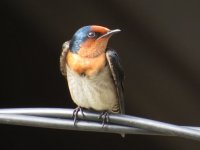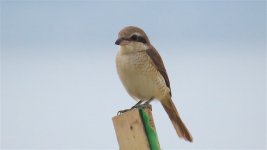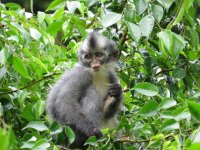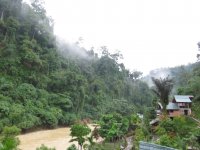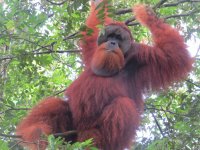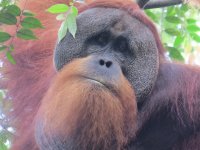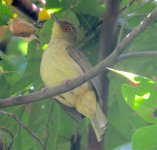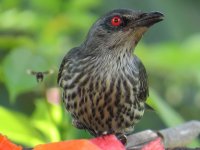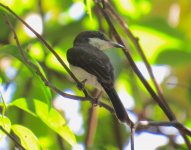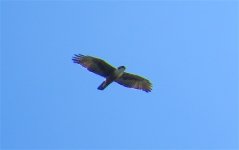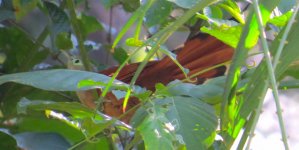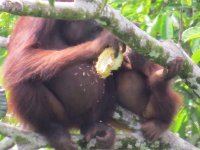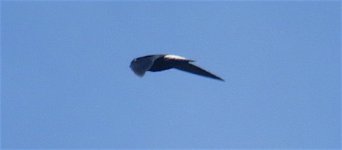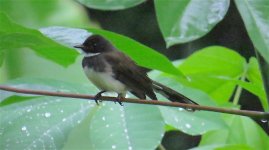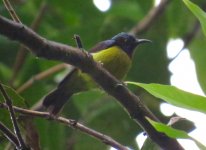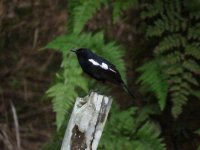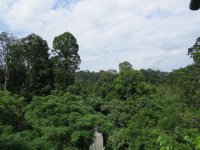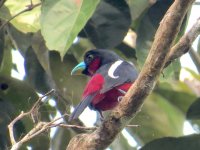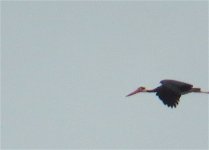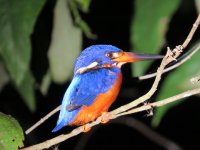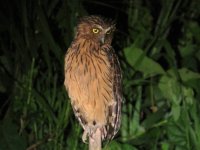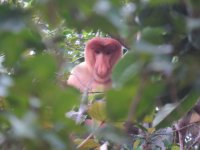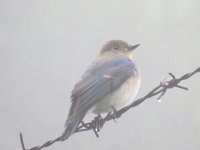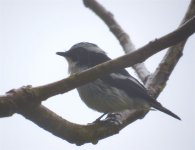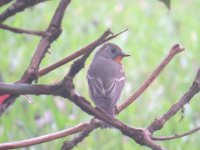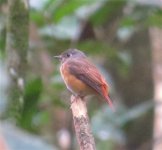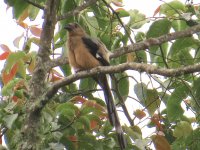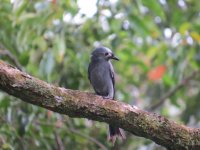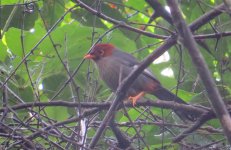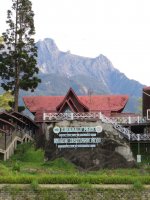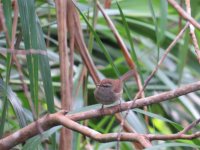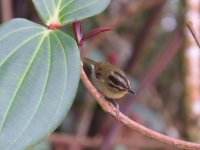dwatsonbirder
Well-known member
Main areas visited:
Gunung Leuser National Park, North Sumatra
Sepilok, Sabah
Kinabatangan River basin, Sabah
Mount Kinabalu, Sabah
Loboc River, Bohol, Philippines
Pamilican island, Philippines
Climate:
During our the period of our trip we had expected to encounter heavy rain daily in all areas, as December marks the beginning of the monsoon period in Sumatra and Borneo, and the end in the Philippines. We were incredibly lucky on the whole during the trip, as the worst rain was encountered only in Sumatra, with occasional downpours or drizzle experienced in Sabah and the Philippines. The weather in Sumatra was rather extreme, with our base of Bukit Lawang experiencing the worst flooding since 2003, and we were evacuated one evening as the river level increased by 3 meters. Temperatures ranged between 28 – 42 degrees, and humidity was generally 95% or higher. Temperatures in Mt. Kinabalu were cooler than in the lowlands (particularly during the evening) and a lightweight fleece is recommended.
Transportation:
Flights to the area are widely available, we flew with Etihad via Abu Dhabi to Kuala Lumpur, and then from there we used AirAsia to move between the three countries. Flights with AirAsia were very reasonable (between £40 - £100 for one way flights) though it is worth upgrading to their premium flex fares, as these allow you to change flights (well worth it as we experienced delays on all our AirAsia flights!) and also include a meal.
If you are planning to undertake a similar trip on a budget, the transport links in all three areas visited were excellent. Public buses in both Sabah and Sumatra were cheap and relatively frequent, and we did on occasion use taxis which though more expensive, were considerably less pricy than in Europe. Tricyles and Jeepney’s are all very affordable for the slightly more adventurous, and scooters can be hired for under £10 a day on the Philippines – very cheap and convenient to bird at your own pace.
Other information:
We booked a few tours in conjunction with our accommodation – Gunung Leuser National Park and Kinabatangan River. These proved to be very good value, and we were lucky to have good guides for both, in particular during our time in the Kinabatangan basin. Guides can be hired, but the quotes I received were a bit above my budget (over £150/day), so as a result I birded alone using information taken from other trip reports or gen from friends. I suspect that if I had used specific guides I would have encountered more birds (particularly in Sepilok and Mt. Kinabalu) but the birding was excellent in these areas even without a guide.
I found the whole time in Gunung Leuser NP to be very hard going with very few birds in general, even when entering the forest before first light. Speaking with the guide I was told the area around Bukit Lawang is a lot quieter than other areas in the park (in particularly north towards Banda Aceh), so this is something to consider if visiting the area. I did enjoy it and was perhaps a bit unlucky, but the encounters with Orangutan in the forest more than make up for the lack of birds.
We didn’t encounter any problems with regards to leeches or ticks (much to my surprise) but mosquito repellent is a must.
I used Craig Robson’s “Birds of South East Asia”, Susan Myer’s “Birds of Borneo” and Kennedy et al “Birds of the Philippines”. I found the first two guides excellent, but I have to say that the plates in the Philippines guide are definitely outdated and overdue an update.
I did take a travel scope with me, but I found that I only used it a handful of times, and you could probably manage without one, particularly if carrying a bridge camera with a good zoom.
Gunung Leuser National Park, North Sumatra
Sepilok, Sabah
Kinabatangan River basin, Sabah
Mount Kinabalu, Sabah
Loboc River, Bohol, Philippines
Pamilican island, Philippines
Climate:
During our the period of our trip we had expected to encounter heavy rain daily in all areas, as December marks the beginning of the monsoon period in Sumatra and Borneo, and the end in the Philippines. We were incredibly lucky on the whole during the trip, as the worst rain was encountered only in Sumatra, with occasional downpours or drizzle experienced in Sabah and the Philippines. The weather in Sumatra was rather extreme, with our base of Bukit Lawang experiencing the worst flooding since 2003, and we were evacuated one evening as the river level increased by 3 meters. Temperatures ranged between 28 – 42 degrees, and humidity was generally 95% or higher. Temperatures in Mt. Kinabalu were cooler than in the lowlands (particularly during the evening) and a lightweight fleece is recommended.
Transportation:
Flights to the area are widely available, we flew with Etihad via Abu Dhabi to Kuala Lumpur, and then from there we used AirAsia to move between the three countries. Flights with AirAsia were very reasonable (between £40 - £100 for one way flights) though it is worth upgrading to their premium flex fares, as these allow you to change flights (well worth it as we experienced delays on all our AirAsia flights!) and also include a meal.
If you are planning to undertake a similar trip on a budget, the transport links in all three areas visited were excellent. Public buses in both Sabah and Sumatra were cheap and relatively frequent, and we did on occasion use taxis which though more expensive, were considerably less pricy than in Europe. Tricyles and Jeepney’s are all very affordable for the slightly more adventurous, and scooters can be hired for under £10 a day on the Philippines – very cheap and convenient to bird at your own pace.
Other information:
We booked a few tours in conjunction with our accommodation – Gunung Leuser National Park and Kinabatangan River. These proved to be very good value, and we were lucky to have good guides for both, in particular during our time in the Kinabatangan basin. Guides can be hired, but the quotes I received were a bit above my budget (over £150/day), so as a result I birded alone using information taken from other trip reports or gen from friends. I suspect that if I had used specific guides I would have encountered more birds (particularly in Sepilok and Mt. Kinabalu) but the birding was excellent in these areas even without a guide.
I found the whole time in Gunung Leuser NP to be very hard going with very few birds in general, even when entering the forest before first light. Speaking with the guide I was told the area around Bukit Lawang is a lot quieter than other areas in the park (in particularly north towards Banda Aceh), so this is something to consider if visiting the area. I did enjoy it and was perhaps a bit unlucky, but the encounters with Orangutan in the forest more than make up for the lack of birds.
We didn’t encounter any problems with regards to leeches or ticks (much to my surprise) but mosquito repellent is a must.
I used Craig Robson’s “Birds of South East Asia”, Susan Myer’s “Birds of Borneo” and Kennedy et al “Birds of the Philippines”. I found the first two guides excellent, but I have to say that the plates in the Philippines guide are definitely outdated and overdue an update.
I did take a travel scope with me, but I found that I only used it a handful of times, and you could probably manage without one, particularly if carrying a bridge camera with a good zoom.




